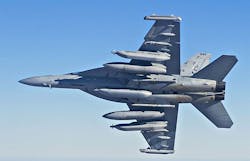Vadum to support electronic-warfare project to counter waveform-agile enemy radar with machine learning
CRANE, Ind. – U.S. Navy avionics experts are looking to electronic warfare (EW) experts at Vadum Inc. in Raleigh, N.C., to support a project that aims at developing detection and classification techniques that identify new or waveform-agile radar threats and automatically respond with an electronic warfare (EW) attack.
Officials of the Naval Surface Warfare Center Crane Division in Crane, Ind., announced a five-year $9.4 million sole-source contract to Vadum on Tuesday to support the Reactive Electronic Attack Measures (REAM) project.
REAM seeks to develop ways of keeping up with rapidly changing enemy radar frequencies, recognizing patterns in frequency shifts, and automatically devising methods to jam or spoof these frequencies-on-the fly.
The REAM project is developing detection and classification techniques that identify new or waveform-agile radar threats and automatically respond with an electronic attack.
Today's airborne EW systems are proficient at identifying analog radar systems that operate on fixed frequencies. Once they identify a hostile radar system, EW aircraft can apply a preprogrammed countermeasure technique.
Related: Adaptive and bistatic electronic warfare
Yet the job of identifying modern digitally programmable radar variants using agile waveforms is becoming more difficult. Modern enemy radar systems are becoming digitally programmable with unknown behaviors and agile waveforms, so identifying and jamming them is becoming increasingly difficult.
Things will get worse in the future as radars develop the ability to sense their environment with artificial intelligence and machine learning, and adapt their transmission characteristics and pulse processing algorithms to defeat attempts to jam them.
New approaches like REAM seek to enable systems to generate effective countermeasures automatically against new, unknown, or ambiguous radar signals in near real-time. They are trying to develop new processing techniques and algorithms that characterize enemy radar systems, jam them electronically, and assess the effectiveness of the applied countermeasures.
Waveform-agile radar systems of the future will shift frequencies quickly in a pre-programmed electronic dance to foil electronic warfare attempts to defeat them.
Related: BAE Systems to develop advanced electronic warfare (EW) to counter enemy programmable radar
Last April the Northrop Grumman Mission Systems segment in Bethpage, N.Y., won a $7.3 million contract to develop machine-learning algorithms for the REAM program. The company is moving machine-learning algorithms to the EA-18G carrier-based electronic warfare jet to counter agile, adaptive, and unknown hostile radars or radar modes. REAM technology is expected to join active Navy fleet squadrons around 2025.
On this week's contract, the Navy is choosing Vadum sole-source to avoid roughly $5.9 million in cost duplication, and prevent as much as three years' unnecessary schedule delay, Navy officials say.
Vadum specializes in EW modeling and simulation. The company has expertise in RF and wireless circuit and systems design; electronic board design, layout, and fabrication; embedded hardware and software design; RF modeling and simulation; computational electromagnetics; antennas; wireless testing; cell phone forensics; servo and stepper motor control; algorithm and digital signal processing development; cryptography; data compression; and RF detection.
On this contract Vadum will do the work in Raleigh, N.C., and will be finished by February 2024. For more information contact Vadum online at www.vaduminc.com, or the Naval Surface Warfare Center-Crane at www.navsea.navy.mil/Home/Warfare-Centers/NSWC-Crane.
Ready to make a purchase? Search the Military & Aerospace Electronics Buyer's Guide for companies, new products, press releases, and videos

